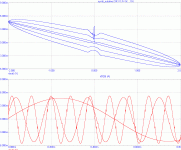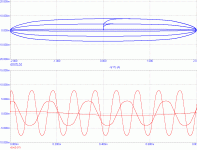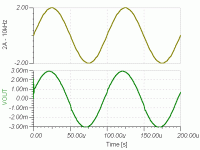Fanuc said:Could you your VAS stage not be speeded up by using a low tranconductance high speed mosfet VAS ?
I'm using a BC550c biased at 30 mA in this location, cascoded with a TO-220 MOSFET (only for safe operating area reasons - it's high voltage). The BC550c has an fT of about 300 MHz in this application, so it's plenty fast. In sim, I tried putting a MOSFET in place of the BC550c, but the simulated distortion was much higher.
Fanuc said:Reading this part of the post made me remember what Doug Self said about this approach (Cherry's scheme) in his power amp design handbook. I believe he cited references to Bob Widlar that said the output stage has to be well controlled to 100Mhz.
http://www.diyaudio.com/forums/showthread.php?postid=666518#post666518
http://www.diyaudio.com/forums/showthread.php?postid=666487#post666487
mikeks said:
This is a non-problem.
Many people here think it is a problem. The truth is that it is a matter of degree. It depends on the designers' choice of component values. It is easily abused, resulting in poor transient response and limited phase margin. On the other hand, moderate use of this technique to increase NFB at HF audio frequencies is generally OK.
Bob
Bob Cordell said:
......On the other hand, moderate use of this technique to increase NFB at HF audio frequencies is generally OK.
Bob
Hi Bob,
In other words, sound efforts to reduce thd by means of this technique (TPC) are limited to moderate results.
Cheers,
I think that Mike is saying that competent designers who understand how to compensate properly will not have a problem. The corollary is that the incompetent will have to wait until Mike is ready to tell us how to do it properly. (sorry Mike if I have paraphrased or even second guessed you incorrectly, but once again I do wish you would be more forthcoming).Bob Cordell said:
Originally posted by mikeks
This is a non-problem.
Many people here think it is a problem. The truth is that it is a matter of degree. It depends on the designers' choice of component values. It is easily abused, resulting in poor transient response and limited phase margin. On the other hand, moderate use of this technique to increase NFB at HF audio frequencies is generally OK.
Bob
andy_c said:
LTSpice is accessible to everybody!It's free from Linear Technology. Because of this, that's what people seem to use most often here when they want to trade sims with each other.
Come on Mike, you can't be serious. As for exchanging schematics, it is ridiculous, at least undemocratic, to raise the rather obscure data format of LTspice as standard, just because it's for free. Besides, this package is targeted to switching regulators in the first place, not audio. I find it unacceptable to force users to download and use S/W they don't like, especially if they are accustomed to better stuff. So tell me, what's so problematic with a well established standard as GIF or PNG? In particular for guys like you, converting to one of these formats should be a snap, isn't it?
estuart said:
Come on Mike, you can't be serious. As for exchanging schematics, it is ridiculous, at least undemocratic, to raise the rather obscure data format of LTspice as standard, just because it's for free. Besides, this package is targeted to switching regulators in the first place, not audio. I find it unacceptable to force users to download and use S/W they don't like, especially if they are accustomed to better stuff. So tell me, what's so problematic with a well established standard as GIF or PNG? In particular for guys like you, converting to one of these formats should be a snap, isn't it?
Well, LTSpice seems to be the de facto standard here because everybody seems to have it; newbees soon discover that it helps immensely the conversations if you have a common baseline; but nobody is forcing anyone to anything.
As for the targeting, I found that LTSpice is pretty much just like any other Spice-based simulator. It may have enhancements to make it better converge with switching regs but that's about it.
I am not aware that there are any specific audio simulators?
Jan Didden
PMA said:Hi Graham,
the story is continuing by different point of view as well:
Hi PMA,
Looks rather nasty, but what is it? Graham's amp?
Cheers,
janneman said:
I am not aware that there are any specific audio simulators?
Jan Didden
Hi Jan,
Micro-Cap (from spectrum-soft) has bunch of functions/features targeted at audio, like thd, fft, distortion residual etc. Besides, this package is extremely easy to use. A fully functional demo version, only limited on components count, is for free.
Cheers,
estuart said:
Hi Jan,
Micro-Cap (from spectrum-soft) has bunch of functions/features targeted at audio, like thd, fft, distortion residual etc. Besides, this package is extremely easy to use. A fully functional demo version, only limited on components count, is for free.
Cheers,
Thanks, I'll check it out. I moved away from MC about 10 years ago when the price went through the roof.
Jan Didden
I saw a couple of plots a moment ago and Edmond asking if it was my amp., but now I cannot see them.
No they were not my amp.
I do not know if I can make the same kind of plot here to demonstrate mine the same way as PMA does.
I have never done this specific test before today, but mine appears to check out with <1mV error for 2A reverse 10kHz sine injection, and visible but nicely smoothed crossover.
But that is Sim only. The sound is what I built upon so this result does not surprise me.
Maybe PMA could check it.
Cheers ......... Graham.
No they were not my amp.
I do not know if I can make the same kind of plot here to demonstrate mine the same way as PMA does.
I have never done this specific test before today, but mine appears to check out with <1mV error for 2A reverse 10kHz sine injection, and visible but nicely smoothed crossover.
But that is Sim only. The sound is what I built upon so this result does not surprise me.
Maybe PMA could check it.
Cheers ......... Graham.
Hi PMA,
Gremlins somewhere ?
Can you give me a #post number ?
Also could you show me your investigation set-up to achieve them please.
Maybe the scope on my simulator will not do it, but I am not changing my simulator or adding another one anyway.
Cheers ......... Graham.
Gremlins somewhere ?
Can you give me a #post number ?
Also could you show me your investigation set-up to achieve them please.
Maybe the scope on my simulator will not do it, but I am not changing my simulator or adding another one anyway.
Cheers ......... Graham.
Hi Hugo,
I did. One moment there, next minute not, and when I posted nothing would make them return.
Anyway the traces.
Post #587.
Presumably there is a suddenly starting sine wave starting at t=0.
At 1kHz little phase shift shows so damping will be linear with little error.
At 10kHz there appears to be a typical leading phase voltage error. Crossover through zero is about 10uS early of 100uS, so likely to sound clean. The zero crossover does not look nice, but I will not try to guess whether it is actually audible; might depend on load, cables etc.
Post #590.
This displays what I personally so dislike about quadrature phase shifted damping.
That is, at moments when dynamic loudspeaker generated back-EMF leads (musically altered) NFB loop controlled amplified input, an instantaneous error voltage is generated which increases linearly with current and frequency because damping current lags the sensed voltage by 90 degrees at each frequency demonstrated. Every fully cycle zero crossover point is shifted by 90 degrees, hence what I stated before, the error is greatest for most of the cycle.
Thus I would still like to know how you generate those elipsoid figures.
Below is the linear graph error simulated for the GEM.
There is still a fractional lead, as with the Symasym only less, though here the class-AB crossover incongruity is smoothed by simultaneous and parrallel connected class-A control within the same NFB loop.
As I said I never checked for this before today.
I did. One moment there, next minute not, and when I posted nothing would make them return.
Anyway the traces.
Post #587.
Presumably there is a suddenly starting sine wave starting at t=0.
At 1kHz little phase shift shows so damping will be linear with little error.
At 10kHz there appears to be a typical leading phase voltage error. Crossover through zero is about 10uS early of 100uS, so likely to sound clean. The zero crossover does not look nice, but I will not try to guess whether it is actually audible; might depend on load, cables etc.
Post #590.
This displays what I personally so dislike about quadrature phase shifted damping.
That is, at moments when dynamic loudspeaker generated back-EMF leads (musically altered) NFB loop controlled amplified input, an instantaneous error voltage is generated which increases linearly with current and frequency because damping current lags the sensed voltage by 90 degrees at each frequency demonstrated. Every fully cycle zero crossover point is shifted by 90 degrees, hence what I stated before, the error is greatest for most of the cycle.
Thus I would still like to know how you generate those elipsoid figures.
Below is the linear graph error simulated for the GEM.
There is still a fractional lead, as with the Symasym only less, though here the class-AB crossover incongruity is smoothed by simultaneous and parrallel connected class-A control within the same NFB loop.
As I said I never checked for this before today.
Attachments
- Home
- Amplifiers
- Solid State
- Bob Cordell Interview: Negative Feedback


